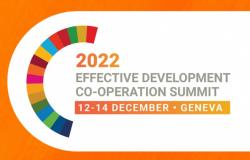The 2022 Effective Development Cooperation Summit: The Pitfalls of Multistakeholderism

Representatives met two weeks ago for the 2022 Effective Development Cooperation Summit. The event reveals the limitations of multistakeholderism and the need for a more politicised approach in global aid politics.
Representatives met last week in Geneva for the 2022 Effective Development Cooperation Summit. This is the latest high-level meeting of the Global Partnership for Effective Development Cooperation (GPEDC): a multi-stakeholder partnership created following the 2011 Busan Forum to promote ‘Aid Effectiveness’ principles. These principles focus on enhancing developing country ownership, a focus on results, transparency and accountability, and inclusive partnerships.
Such multi-stakeholder partnerships are near ubiquitous across global governance. Compared to intergovernmental organisations, these partnerships are much more informal, inclusive of nonstate actors, and rely upon voluntary actions and consensus. The GPEDC is among the most ambitious in its attempt to encompass the full swathe of global development actors. The origins of the partnership can be traced to the OECD Development Assistance Committee’s (DAC) 1996 Shaping the 21st Century Report. Following a decade of criticism, the donor community committed to moving from its paternalistic monopoly on global aid governance. It initiated the ‘Aid Effectiveness’ reform process that would involve both a reflection on its own aid practices while broadening its governance auspices to include a global partnership of recipient state and nonstate actors.
In this aspiration towards ‘global’ and multi-stakeholder inclusion, discussions on who was and wasn’t present at high-level events are of foremost concern. The 2022 meeting was, in this regard, a bit of a damp squib compared to earlier meetings. At Geneva there were roughly 500 on-site participants: a significant decline from the 4,000 at the second meeting in 2016 in Nairobi, or the 1,500 at the first meeting in 2014 in Mexico. I was assured by the organisers, however, that over 4,000 were attending the event virtually. Perhaps we can give these figures the benefit of the doubt.
Yet this declining engagement was most apparent among its progenitors: the traditional donors of the OECD-DAC. Though the GPEDC is often criticised on the basis that it constitutes yet another donor-dominated forum, the donors themselves have long moved on from the aid effectiveness agenda. Once upon a time the US would send the likes of Hilary Clinton to attend ‘high-level’ Aid Effectiveness meetings. Now, some DAC members send junior officers, if at all, and only after significant behind-the-scenes arm twisting by the OECD secretariat.
One of the drivers for declining donor engagement has been the failure of the GPEDC to incorporate the ‘new’ Southern providers of South-South Cooperation (SSC) – principally China, Brazil, and India. These actors felt that the GPEDC constitutes a DAC-driven attempt to ensnare them within an accountability process not of their own making. They have, therefore, kept their distance. With these major Southern powers absent, the term ‘Global Partnership’ has been a misnomer. Yet this was the first event where China attended. Granted, Mr Xu Wei - Director-General of International Cooperation Department, Chinese International Development Co-operation Agency - did not talk about the relevance of Aid Effectiveness to China’s activities. He instead used his intervention to publicise Xi Xingping’s ambitious ‘Global Development Initiative’ as a focal point of China’s Development strategy. But using one’s allotted ‘5 minutes’ in an over-packed panel discussion to either self-congratulate or promote national initiatives tends to be the norm at these events, particularly for providers.
On the non-state side, civil society often constitutes the only critical voices in the room. This event was no exception. CSOs today need to contend with an ever-rapidly shrinking civic space: the GPEDC offers a rare haven for engagement, and a vehicle towards encouraging civic engagement at the national level. Yet like much of the development field, the GPEDC has dialled up efforts to court the private sector in recent years. Multistakeholder partnerships have been frequently criticised on the basis that they constitute the ‘privatisation’ of global governance. Interestingly, however, the GPEDC and its 2022 meeting shows that the private sector need not even be present for this to be the case. The meeting was awash with donor, international organisation, and middle-income country declarations on the need to use public aid to ‘unlock’, ‘catalyse’, ‘de-risk’ - or in plain terms ‘subsidise’ – private investment. Yet given the lack of private sector presence, it seems that such ‘untapped potential’ is yet to also be realised on the side of the private sector.
The Summit nevertheless announced a stakeholder-specific toolkit for the Kampala Principles on Effective Private Sector Engagement that can normatively guide private sector engagement at country level. Furthermore, the Summit announced that the Kampala Principles will be incorporated within the revised monitoring process (see below), not least due to the efforts of committed CSO representatives within the partnership. This is all voluntary of-course, and not likely to upset any apple carts. But once in place, this will be a significant milestone towards monitoring private sector engagement at country level.
Often these events centre around the results of a monitoring process: how well country stakeholders have advanced against operationalised ‘Aid Effectiveness’ principles. In this regard, the GPEDC’s biennial monitoring process is the ‘jewel in the crown’ of the GPEDC process. It once offered recipients one of the few tools available to hold donors to account for their commitments, and advance progress towards what recipient countries term the ‘unfinished business’ of realising country ownership and self-determination. The monitoring process is perhaps the greatest driver towards recipient country enthusiasm for the GPEDC - evidenced by the very high-level of recipient country representation at these events, in stark contrast to the DAC donors - with over 80 countries participating in the last round, while the monitoring reports actually inform country reform processes.

‘A multistakehodler motley crew’. Pictured left to right: Vitalice Meja (Non-Executive Co-chair), Maia Sandu (President of Moldova), Ignazio Cassis (President of Swiss Confederation), Paul Kagame (President of Rwanda), and Amina J. Mohammed (Deputy Secretary General of the United Nations).
Yet the 2022 meeting had no monitoring results to show for. Instead, efforts these past years have been focused on producing a ‘revised’ monitoring process, one that potentially files the teeth of the GPEDC’s accountability bite. Perhaps the greatest fault with the monitoring exercise is that it situates the ‘problem’ of ineffective development cooperation firmly within recipient countries. The monitoring process, pre-Busan, was about ensuring both recipients and donors were held account for progress against Aid Effectiveness indicators. Today, however, the monitoring indicators are weighted heavily towards assessing shortcomings and realising ‘behaviour change’ at recipient country level, effectively letting donors off the hook for their lack of progress. There seems to be very little, if any, recognition – and certainly no appetite - among donors as to whether a more stringent accountability mechanism is necessary to monitor their behaviour. Not least from the incoming Swedish co-chair who was keen to repeatedly insist upon the more general problem of ‘corruption’ in developing countries, and the promise of ‘catalysed’ private finance as a panacea for financing gaps.
Rather, the GPEDC monitoring process is moving towards a less frequent, four-year ‘rolling process’. That means fewer events and monitoring reports to highlight progress against the ‘unfinished business’ of the Aid Effectiveness agenda. Instead, there will be a virtual dashboard, where the interested can periodically check in to see some technical and disparate figures, no longer situated against headline, biennial trends.
It was unclear as to who or what was driving these revisions to the monitoring framework. There were some mummering that this was simply a ‘technical’ change towards bringing the process in line with political cycles, and one made by apparent multi-stakeholder consensus. Yet it is important to remember that this a process that started out in 2005 in Paris as a genuine, commitment-driven agenda of donor-recipient accountability. What is clear, however, is that there is a level of informality, ‘technicality’, and multi-stakeholder inclusivity where very little pressure is applied and, thus, little progress is made. And for those whose interest lies in the maintenance of long-standing power hierarchies; this is a feature: not a bug. The GPEDC’s ‘gently-softly’, consensus-based, well-groomed, and overly sanitised approach to international governance does a good job of making diverse stakeholders feel included in processes, plenaries, and discussions. Yet towards the underlying reason as to why we really ought to have such an institution – offering a genuine forum for donor-recipient accountability and pushing the needle towards country ownership - such an approach does not work.
As one astute Southern CSO representative remarked during a lunch break: ‘Donors will not simply give country ownership to recipient countries’. It cannot be picked up in a break-out session, it will not come in a tote bag, nor will it be produced by tinkering with monitoring indicators. Country ownership needs to be taken. And for that, we need a messier, less technical and, perhaps even, a more adversarial politics. Sometimes, that means that we need to abandon the drive for consensus and constant ‘horizon scanning’ exercises for ‘the next big thing’. Instead, the agenda may require a move back to the ‘old’ politics of collective inter-state bargaining between blocs of recipients and providers: making donors sit up by holding their feet to the fire. This may also mean moving away from highly choreographed panel ‘discussions’ and the performance of multi-stakeholder ‘collaboration’, and instead creating a space where the powerful may be embarrassed during unscripted moments and exchanges. For now, however, the GPEDC process is a light affair. It is moving further away from its transformative potential to provide a vehicle for recipient empowerment. We thus end up with more of a trade fair than an international summit, with very little politics - and promise - on show.
Dr Jack Taggart is a Lecturer in International Political Economy at Queen’s University, Belfast. His research examines the politics and dynamics of global governance and international development.
Image: Official event photo (CC BY 2.0)


